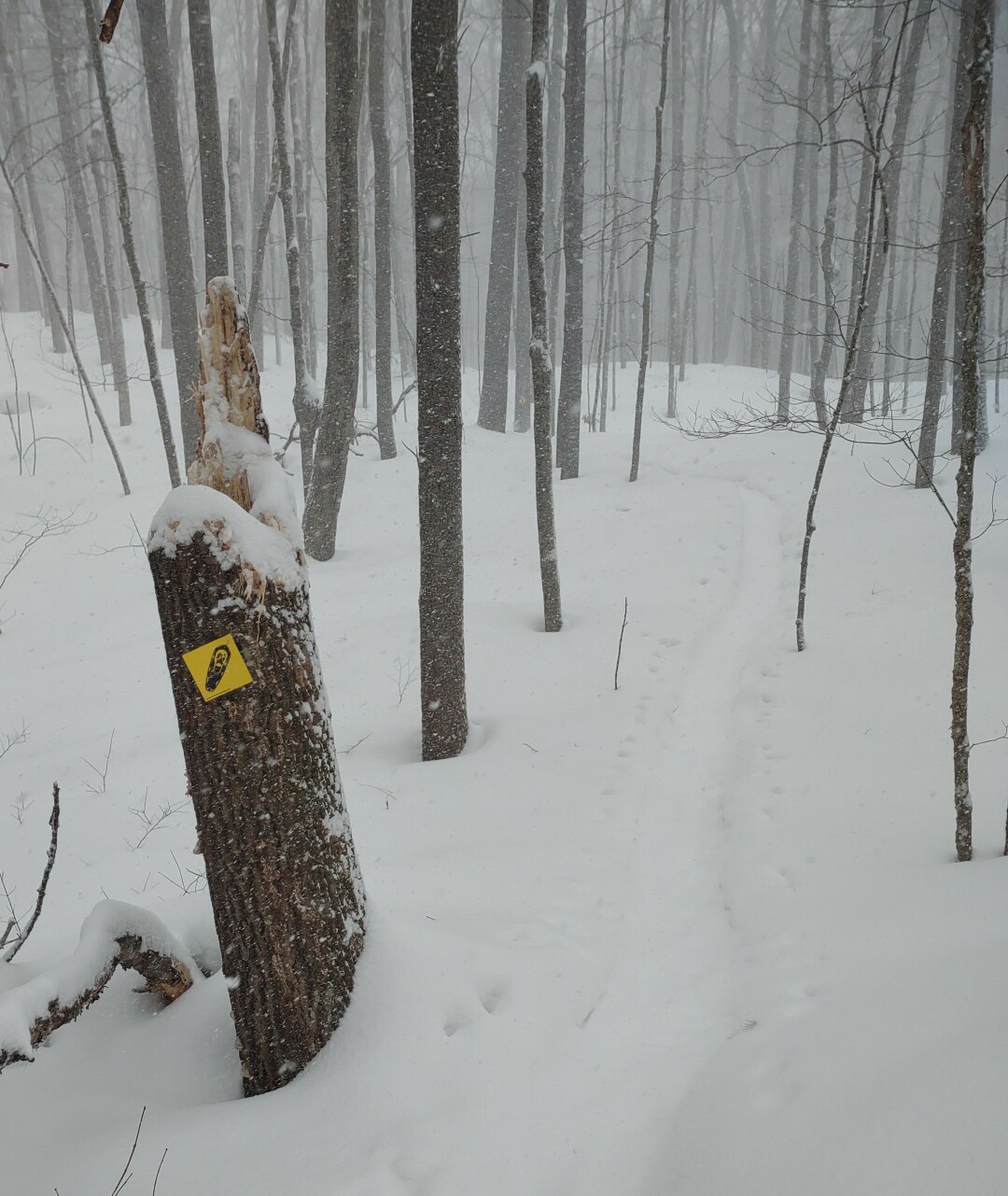Snowshoe field trip

Snow fell fast enough to cover up our tracks on the Mammal Tour at the North End snowshoe trail. Photo by Emily Stone.
Thick clouds of snowflakes swirled as I climbed the steep hill. Behind me, a string of 20 third graders from Hayward Intermediate School padded along on the Cable Natural History Museum’s rental snowshoes.
Their feet were quieter than usual–in many years the trails are hard-packed ice by the time we embark on this annual field trip. This year, fresh snow dampened the crunch of plastic and metal.
The students themselves were just as talkative as ever. Barely out of sight of the big yellow school bus, they’d started in with the cries of “I’m tired! I’m hungry! Are we there yet?” By age 9, they were already finding humor in what they knew to be cliché’ (even if that word has yet to appear on a spelling test).
When the upper branches of a freshly fallen tree appeared ahead of us, I took quick stock of the options. “Are you ready for an adventure?” I asked, and led the students through fresh snow, up a steep bank, onto the high angle of the hillside above the trail, and then back down. “Yes! More adventure!” cried the eager ones at the front of the line.
While the less adventurous ones struggled with the hill, I texted Rich Jaworski, the new director of the museum. By the time we passed that way again, the tree had magically disappeared, even the sawdust covered by snow. This field trip is designed around the Mammal Tour at the North End Trailhead, a roughly 1-mile loop trail where we’ve placed life-size metal silhouettes of 25 Wisconsin mammals.
But when we got to the start of the main loop, the first metal animal was nowhere to be seen. I gingerly stepped around the mound where I thought it should be, but no badger appeared. Forging ahead without the visual aid, I asked, “What are badgers really good at?”
“Basketball and football!” was the response. Digging dens is what I’d been thinking.
The woodchuck and chipmunk were also deeply buried by crusty layers of snow and ice. But the wolf’s nose was howling out of a drift, and not far away the deer’s antlers beckoned, too. At the trailhead, I’d given two students backpacks to carry, and now their jaws dropped as I pulled a full, fluffy wolf pelt from one of the packs.
After petting the fur, we talked about how wolves’ big feet help them stay on top of the snow, especially crusty spring snow. In contrast, deer’s sharp hooves–well suited for running quietly and efficiently through the leaf litter–punch through the crust and allow their owner to be caught.
There was no crust on this day. The snow fell so fast that our tracks were obscured by the time we completed the loop less than two hours later. And the talk of venison for a wolf’s dinner must have made some kids hungry, because they scooped up big handfuls of fresh snow and ate messily. “Just so you can make an informed decision,” I told them, “every single snowflake has a piece of dust or bacteria at its center.” No one was deterred.
On the second morning (it takes four rounds to get 102 third graders out on trail!) sunshine beamed down instead of snow. Just before the corner of the missing badger, tiny tracks quilted the drifts. Mice had darted from tree to tree in last night’s moonlight. I couldn’t resist pointing them out.
“Who made these?” I asked the kids. “Deer! Fox! Rabbit! Squirrel!” they shouted, clearly not computing that the track-maker’s feet were less than half an inch long.
“All winter,” I told them, “mice live in a magical space where snow and ground come together.” “I know what it’s called!” yelled a kid from the back of the line.
“So,” I continued, “when you look out in the woods and see this blank snow, you can also imagine entire mouse cities and civilizations hidden underneath, where they are eating, sleeping, fighting, playing, and having babies all winter long. This magical place is called…” and I gestured to the kid…
"The subnivean zone!” he yelled proudly. “I learned that from Wild Kratts” he added.
The mice often use the base of a tree as a gateway between the subnivean zone and the surface, I explained, but sometimes they just burrow straight into the snow. With eyes alert as we hiked, these portal holes appeared everywhere.
Back at the corner of the missing badger, we recapped. “Today we learned about things that animals have and do that help them survive the winter. And we put some adaptations on ourselves, too. What adaptations am I talking about?” I asked. “Snowshoes!” they yelled. And then we tromped down the hill to take them off.
Emily Stone is Naturalist/Education Director at the Cable Natural History Museum. Her award-winning second book, Natural Connections: Dreaming of an Elfin Skimmer, is now available to purchase at www.cablemuseum.org/books and at your local independent bookstore, too. For more than 50 years, the Cable Natural History Museum has served to connect you to the Northwoods. Our Growing Up WILD exhibit will close on March 15, and The Northwoods ROCKS will open on May 2, 2023. Follow us on Facebook, Instagram, YouTube, and cablemuseum.org to see what we are up to
